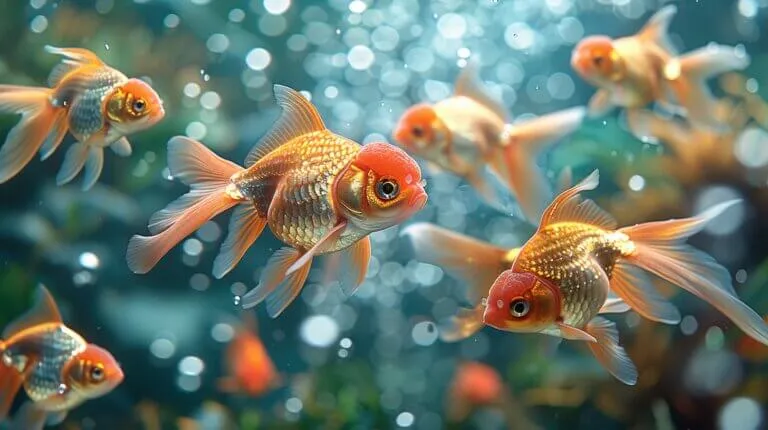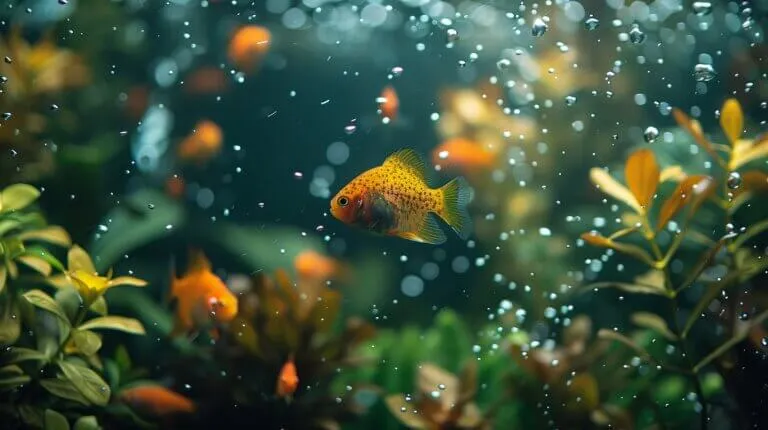Feeding your betta fish can be tricky. Many owners struggle to get it right. But don’t worry – we’ve got you covered. This guide will show you how much to feed beta fish for optimal health. 2
As an experienced aquarist, I’ve kept bettas for years. I’ve learned the ins and outs of their care through trial and error. Proper feeding is key to a happy, healthy betta. 1 Ready to become a betta feeding pro? Let’s get started.
Key Takeaways
- Feed adult bettas 2 to 4 pellets once or twice daily. The pellets should be about the size of the betta’s eye.
- Remove uneaten food after 5 minutes to keep the tank clean. Your betta’s belly should be slightly rounded after eating the right amount of betta fish food., not bloated or distended abdomen.
- Try mixing in freeze-dried or frozen food once a week. This will give your betta fish different kinds of food.
- Fast your betta one day a week to help their digestion. Bettas can live without food for 1 to 2 weeks.
- Create a natural feeding space with live plants and hiding spots. Scatter food around the tank to encourage hunting behavior.
Understanding the Dietary Needs of Betta Fish

Bettas need a diet rich in protein to thrive. Your finned friend’s meals should mimic what they’d eat in the wild – mainly insects and small crustaceans.
Recognizing the Signs of a Healthy Betta Diet
A healthy betta fish shows clear signs of a good diet. Look for a slightly rounded belly after meals. This means your betta is eating well. 2 The fish’s colors should be bright and vibrant. Active swimming and exploring the tank are also positive signs.
Keep an eye on your betta’s weight over time to ensure you are not feeding your betta fish too much. A stable weight indicates proper feeding. Reduce food if your betta gains too much. Increase portions if it loses weight. Offer high-protein treats once or twice a week.
This mimics their natural diet in the wild, which includes foraging for food. Your betta will thrive with the right balance of nutrition and portion control.
The Role of Protein in a Betta’s Diet
Protein plays a crucial role in your betta’s diet. These fish need a high-protein menu to stay healthy and vibrant. Experts suggest that 35% of their food should be protein. 1 This nutrient helps keep their colors bright and their bodies strong.
Bettas are carnivores. They thrive on protein-rich foods like bloodworms and brine shrimp. These treats mimic what they’d eat in the wild. Pellets made for bettas also pack a protein punch.2 Mix up their meals to give them all the nutrients they need.
A varied diet keeps your fish happy and active in their tank.
Feed your betta right, and watch them shine!
How Much to Feed Your Betta: Portion Guidelines

Feeding your betta fish the right amount is key. You’ll need to know the ideal portion size and how often to feed them.
Determining the Ideal Portion Size for Your Betta
Start with 3 to 4 North Fin Betta Bits daily. Slowly increase the food as your fish grows. Don’t worry if you miss a day – bettas can live without food for 1 to 2 weeks.
Bettas need the right amount of food to stay healthy. Give your betta 2 to 4 pellets per meal. 3 The pellets should be about the size of your betta’s eye.
Watch how much your betta eats in 5 minutes. Your betta’s belly should be slightly rounded after eating, not bloated. Adjust the portion size based on your fish’s appetite and activity level.
A happy, well-fed betta will be active and have bright colors.
Frequency of Feeding: Establishing a Routine
Now that you know how much to feed your betta, let’s talk about when to feed them. Set a feeding schedule for your betta fish. Feed adult bettas once or twice daily. Give them food in the morning and evening if you choose twice.
Stick to this routine six days a week. On the seventh day, fast your betta to help their digestion.3 For baby bettas, offer food twice daily to support growth. Always remove uneaten food after five minutes to keep the tank clean. 2
The Risks of Overfeeding Your Betta

Overfeeding your betta can lead to big problems. Too much food can make your fish sick and mess up your tank’s water.
Identifying Signs of Overfeeding in Bettas
Your betta’s belly tells a lot. A bloated stomach is a clear sign you’re giving too much food. 2 Keep an eye on your fish’s body shape. If it looks round or swollen, cut back on meals.
Bettas often eat more than they need when food is always there. This can cause health issues like constipation or swim bladder problems. 4
Watch how your betta moves after eating. If it struggles to swim or sinks to the bottom, you may be overfeeding. Check the tank for leftover food. Uneaten bits mean you’re giving more than needed.
Weigh your betta regularly. If it’s gaining weight fast, reduce portions. These signs help you determine how much and how often to feed your betta fish food just right.
Preventing Overfeeding: Best Practices for Owners
Now that you know the signs of overfeeding, let’s focus on prevention. These tips will help you keep your betta healthy and happy:
- Feed small amounts: Give your betta fish 2 to 4 pellets every day. Their belly should look a little round, not too big, which means they are eating the right amount of food.
- Stick to at schedule: Feed at the same times each day. Your betta will learn when to expect food.
- Remove uneaten food: Take out any leftover bits after 5 minutes. This stops your betta from eating too much.
- Use the right food: Pick high-quality betta food pellets or flakes for optimal nutrition. They have the protein bettas need.
- Offer variety: Try adding freeze-dried or frozen food to your betta’s diet once a week. This will give them different kinds of food to eat.
- Watch your betta eat: Make sure they finish all the food you give. If not, cut back next time.
- Skip a day: Don’t feed your betta one day a week. This helps their digestion and reduces the risk of bacterial infections.
- Measure carefully: Use a small spoon or your fingertip to portion food. Don’t guess.
- Adjust for tank size: Bigger tanks may need more food. Smaller ones need less.
- Keep water clean: Change 25% of the water weekly. Clean water helps digestion.5 2
Diversifying Diet: Incorporating Live Food and Alternatives

Live food can spice up your betta’s meals. Try bloodworms or brine shrimp for a tasty treat.
Benefits of Live Food for Bettas
Live foods offer huge perks for your betta fish. They mimic a betta’s natural diet, sparking their hunting instincts. 1 Mosquito larvae pack a protein punch, vital for these tiny carnivores. 3 Feeding live prey keeps your betta active and engaged, boosting their overall health.
You’ll see your betta’s true colors shine with a live food diet. Their fins may grow fuller and their scales more vibrant. Plus, live foods often carry fewer preservatives than packaged options.
This natural approach can lead to a happier, healthier fish that thrives in your tank.4
Safe and Nutritious Alternatives to Live Food
Live food is good, but it’s sometimes hard to get. Freeze-dried bugs and crustaceans are a good choice instead. They have lots of protein and no extra stuff.
For office tanks, soaked freeze-dried foods work well. They’re easy to store and use. Plus, you can boost their nutrition by soaking them in a vitamin mix. This step helps replace any lost nutrients. Your betta will still get a tasty, healthy meal without the fuss of live prey.
Frozen foods are another good option. They’re often more nutritious than flakes or pellets. You can find frozen brine shrimp, bloodworms, and daphnia at most pet stores. These foods closely mimic a betta’s natural diet.
Only thaw a little bit of food at a time before feeding your betta. Take away any leftover food after five minutes to keep the tank clean. By using these different foods, you can give your betta a healthy diet that’s easy for you to manage. 1
Feeding Your Betta Naturally: Mimicking Wild Diet Habits

Bettas in the wild hunt small insects and larvae. You can copy this by adding live or frozen foods to your betta’s diet.
Understanding Betta’s Natural Feeding Patterns
In the wild, bettas eat small insects and larvae. They hunt for food throughout the day. Their diet is high in protein from mosquito larvae and other tiny bugs. 6 You’ll see bettas swim to the water’s surface to catch prey. This natural pattern helps them stay active and healthy.
To mimic this in your tank, feed small amounts 2 to 3 times daily. Offer protein-rich foods like brine shrimp or bloodworms. Spread meals out to keep your betta moving and searching. This matches their instincts and boosts their well-being.
Fasting once a week also copies wild feeding habits. 1
Creating an Environment for Natural Feeding Behaviors
Create a natural feeding space for your betta. Add live plants and hiding spots to mimic their wild habitat. This setup lets your betta hunt and forage like they would in nature.
Scatter food around the tank instead of dropping it in one spot. Your betta will swim and search, getting exercise and mental stimulation.
Use a variety of foods to match your betta’s natural diet. Offer small insects, worms, and crustaceans. These foods tap into your betta’s hunting instincts. Feed 2 to 4 pellets or 2 to 3 pieces of live food once or twice daily.
Betta fish have stomachs about the size of their eyes. 3 Stick to a regular feeding schedule to keep your betta healthy and prevent feeding them too much.1
Conclusion
Feeding your betta right keeps them happy and healthy. You now know how much to give and how often. Stick to a routine and watch for signs of overfeeding. Mix up their diet with live food and safe alternatives.
With these tips, your betta will thrive in its aquarium home..
FAQs
1. How often should I feed my betta fish?
Feed your betta twice a day. Give small amounts they can eat in 2 to 3 minutes. Don’t overfeed – it’s bad for their tummy.
2. What’s the best food for bettas?
Bettas like high protein treats. Try pellets, freeze-dried, or live food. Mix it up to keep them happy. Make sure the pellet size fits their mouth.
3. Can I leave my betta without food when I’m away?
Bettas can’t fast long. For short trips, use a fish feeder. For longer times, get a trusted fish sitter. Don’t let them go hungry!
4. How do I know if I’m feeding too much?
Look at their belly. If it’s big or swollen, you’re giving too much. Excess food can make the water dirty and harm your fish.
5. Does water temperature affect how much I should feed?
Warm water helps betta fish digest their food better. Use a thermometer and heater to keep the water at the right temperature (77-80 degrees Fahrenheit). Adjust how much food you give your betta based on the water temperature.
6. Are there foods I should avoid giving my betta?
Skip human food. It can make them sick. Stick to fish food made for bettas. Fresh food is best – old food loses vitamins.





